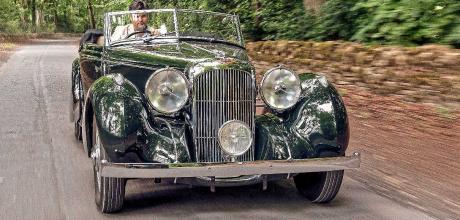1939 Lagonda V12 Rapide
Back in the UK after more than half a century undercover, this Lagonda V12 Rapide once belonged to a top British spy. But as we discover, it may have inspired fictional escapades too.
Words SAM DAWSON
Photography LAURENS PARSONS
On His Majesty’s Secret Service
Driving a spy’s Lagonda — is it the real-life Bond car?
Lagonda V12 Rapide driven Declassified: the Lagonda V12 that lived a life of WWII espionage
London, April 1942. With the Luftwaffe’s Blitzkrieg campaign stalled for nearly a year, the capital is shaken, but attempting to get itself towards something approaching normal, even as war rages across the Channel. The barrage balloons still loom in a blackout sky around the Docklands, but in the exclusive world of private members’ clubs and casinos in the heart of the West End, London’s high society is dusting itself off and getting back on its feet.
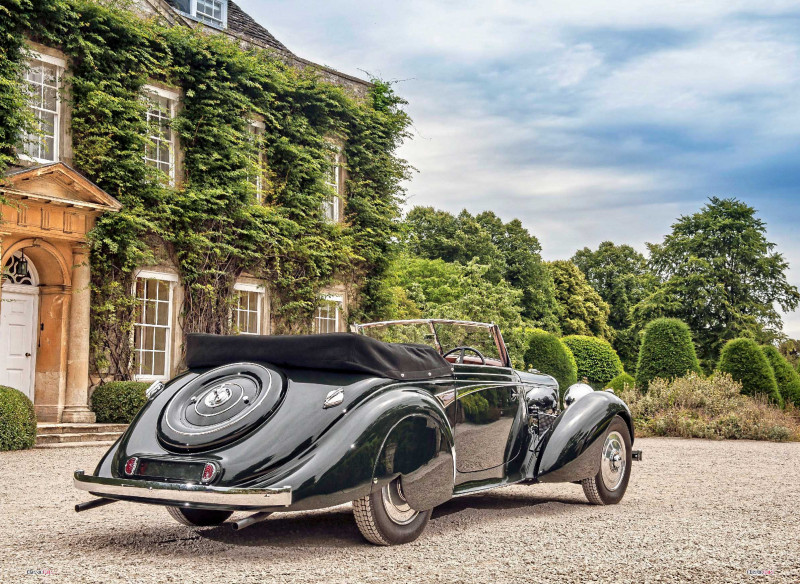
This unique, flamboyant Lagonda V12 Rapide, essentially a stillborn Le Mans racer clad in James Young civvies, commissioned during peacetime’s last gasp, sits by the kerb outside Mayfair’s Five Hundred Club. It’s an unusually indulgent sight during an era of rationing, but to Charles Mackintosh it’s a sign that his friend, Major Godfrey Anthony Gillson, is in tonight.
Clad in a club-regulation dinner jacket, Mackintosh navigates his way through the drifting cigar smoke and sultry big-band swing, between the off-duty military officers and debutants, and finds Gillson conversing with a glamorous young woman in fluent French. The dashing 33-year-old officer of the King’s Own Scottish Borderers is particularly keen for the woman, Margaret de Roche, to meet Mackintosh, because he thinks he may be able to help her in her important work for the French Resistance. De Roche doesn’t realise it, but she’s walked straight into a trap. Gillson is a top MI5 security-service agent, sufficiently debonair and well-travelled to spot glaring holes in her backstory about her apparent Swiss identity without her suspecting a thing. How can she come from Lausanne and not know Montbenon? She’s a double-agent, and the perfect conduit with which to issue any further agents with 25 marked false passports for easy identification should they attempt to enter the country. Her potential loyalty to the Allies would be tested by her adherence to the plan. A plot devised by Gillson’s immediate line manager, John Bingham, in charge of the Political Subversion Section. A young postwar MI5 recruit, Bernard Cornwell – aka John le Carré – would later immortalise the older Bingham in fiction in the form of George Smiley. Eighty years later, I swing the driver’s door wide, settle into the Lagonda’s comfortable, supply-sprung sofa of a driver’s seat, and turn the ignition key, hearing the Le Mans-specification V12 bark and burble into life. I find myself contemplating the mindset and lifestyle of the heroic yet clandestine person who commissioned it. Gillson’s life as a spy was one of the country’s closest-guarded secrets, and yet he was a suave figure with a high public profile. A racehorse owner on first-name terms with Royalty, married to American heiress Priscilla Dickerson. The couple’s 1938-9 renovation of Cornwell Manor was the subject of a major feature in Country Life magazine in May 1941. Today, I’m returning Gillson’s Lagonda to Cornwell Manor for the first time since it left here in 1944.
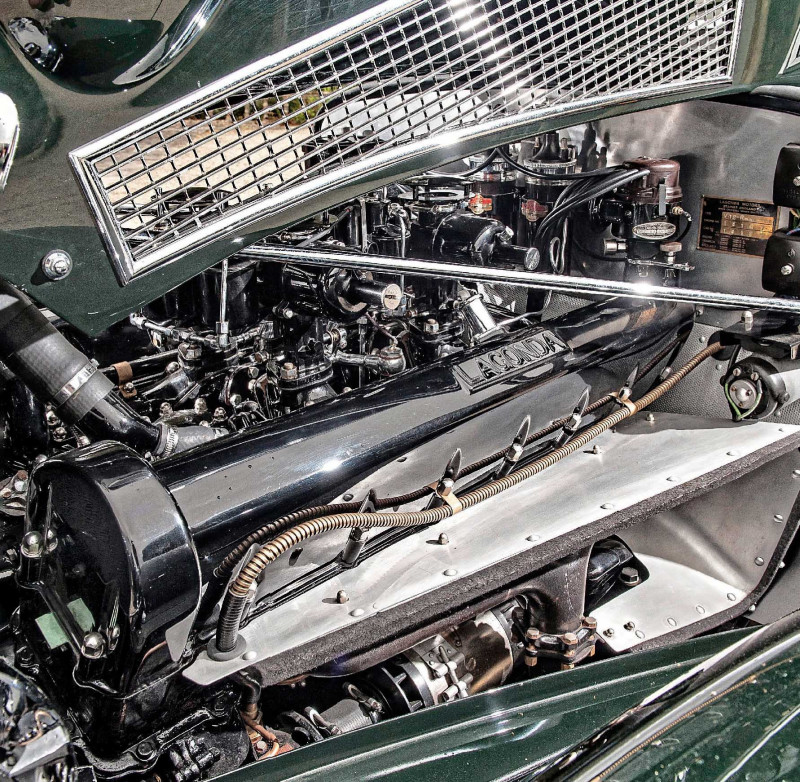
Unlike many pre-war cars – even some supposedly luxurious ones – it’s spacious in this Lagonda’s cockpit once you’ve negotiated the enormous steering wheel. The gearbox has a long-throw lever transmitting a sense that you’re moving hefty metallic components around with it, but it’s remarkably slick and direct in its operation, sufficiently modern-feeling to remind me more of a Seventies Range Rover than most of the vague, harsh, heavy, clanking gearshifts I’ve experienced in other cars of this Lagonda’s epoch.
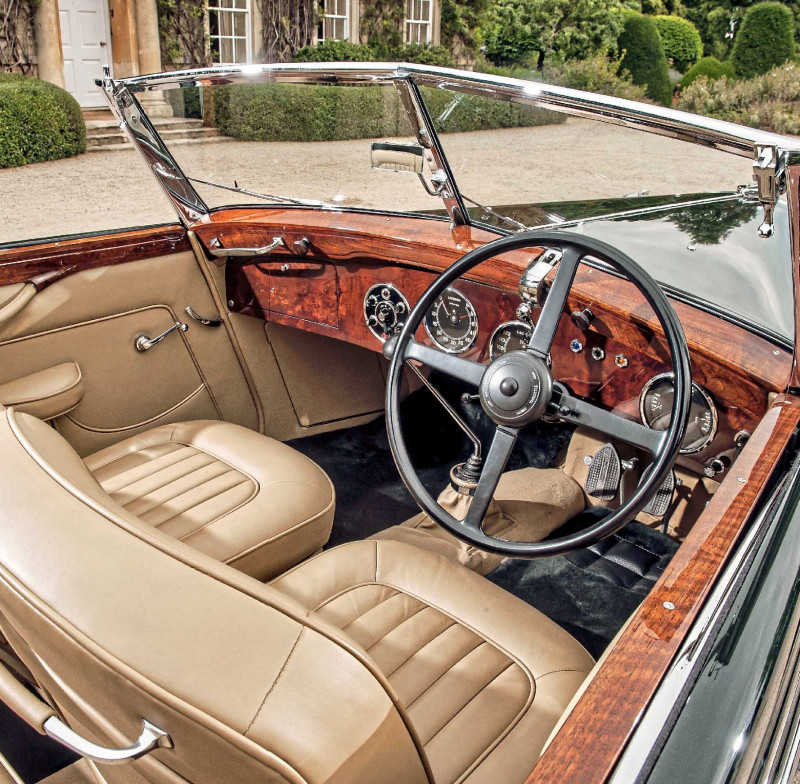
And then there’s the engine. It’s a Sanction IV unit originally earmarked for Lagonda’s works Le Mans racers, for the 1940 racing campaign curtailed by the outbreak of war. This WO Bentley-designed unit packs 180bhp and 110mph capability. That’s only warm-hatch territory nowadays, but in 1939 when the most common car on British roads was a 24bhp, 60mph Austin Seven, the Lagonda V12 Rapide was a shatteringly fast supercar. Given the Le Mans origins of its engine, its modern equivalent would be something like an Aston Martin Valkyrie. But despite this it’s so tractable, so smooth. And a comfortable four-seater grand tourer rather than a bare-bones supercar. Rather than refusing to co-operate unless it’s revved on-cam, it pulls seamlessly from rest, seeming almost leisurely until I glance at the speedometer and find myself closing on 50 miles per hour not long after shifting into third gear on a narrow Gloucestershire lane. It feels more like 30.
Part of the trick it plays is the way it seems to get quieter as it picks up speed. This is to some extent because of the inherent balance of a V12 engine. There’s no off-beat, just a seamless surge of torque with an accompanying snarl under initial acceleration, which dissipates to a whisper as the gear whine rises. It’s a good idea not to get too complacent though. The brake pedal feels spongy beneath my right foot, the relatively weak drums the only element of the way the Lagonda drives that really feels its age. You need to think a long way ahead when driving it, anticipating long braking distances, wondering who might be lurking around the next corner, just like a spy.
That said, unlike a lot of pre-war cars, I can actually imagine sitting back, relaxing and covering hundreds of miles with ease in this car. Just as well for Gillson, because he probably had a lot on his mind. Gillson was no ordinary MI5 agent, even given his rarified background. At other times during the Second World War, this Lagonda found itself parked in Pimlico’s Dolphin Square as Gillson met directly with Maxwell Knight, the MI5 spymaster known as ‘M’. According to Knight’s biographer Henry Hemming, agents who reported directly to Knight were personally approved by him, the ‘one-man membership committee’, and this elite cabal of spies were known as Knight’s Black Agents. Each had a code number prefixed with ‘M/’, and given the desperate circumstances of war plus the fact that at the time, MI5 was not recognised by law, there were technically no legal limits to the powers exercised by the Black Agents. Even among this elite unit, Major Gillson would have stood out as much as his car. Although Knight selected agents from across the entire social spectrum, many of his recruits were wounded ex-servicemen and those too disabled to be conscripted. People who’d be underestimated by their foes, or who could blend unquestioned into civilian society. But Gillson performed their function in the exclusive places only the wealthiest and best-connected could access.
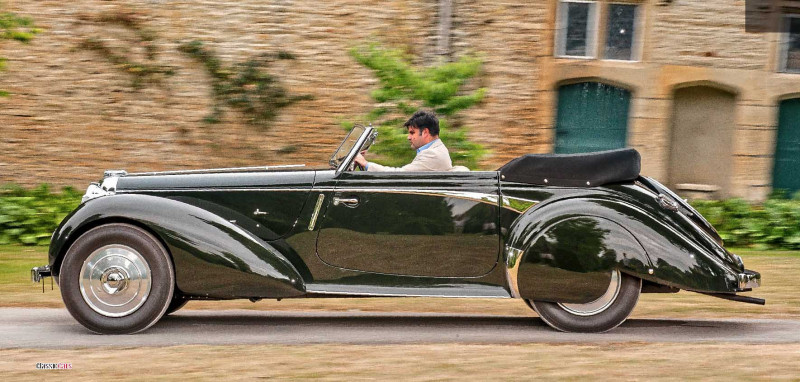
As I revel in the Lagonda’s surprisingly sharp, responsive steering negotiating Cotswold bends, my mind starts to join dots and start speculating. A high-class, multilingual British secret agent, at home wearing a dinner jacket in the clubs of Mayfair, dashing about town in a race-bred WO Bentley creation, highly visible yet covertly part of a group of elite, numbered agents with – potentially – a licence to kill. Major Gillson is definitely starting to remind me of someone…
Like James Bond, Gillson was certainly a connoisseur of high style; this V12 Rapide radiates it and Gillson’s order in coachbuilder James Young’s books proves as much. Ordinarily, Lagondas of this era were supplied to various coachbuilders with all bodywork forward of the windscreen, plus wings and running boards, already in place. Gillson’s build sheet dictated ‘No Bonnet; No Headlamps; “Lo” Radiator Shell; No front wing assembly.’ In short, the car’s final art-deco form would be sleek, cohesive, and entirely the work of Scottish designer AF McNeill, lured to James Young from Gurney Nutting in 1937. His name is not as well-known as that of his best-known apprentice John Blatchley, but the man who went on to shape the Bentley R-type Continental less than ten war-torn years later learned his trade from this car’s stylist.
This Lagonda is an exemplary piece of British art deco. While the French school still featured the plantlike chromed creepers of the art-nouveau movement and the Americans embraced a combination of exiled German Bauhaus practitioners and bold Tutenkhamun-inspired Egyptomania, the domestic interpretation treads a measured line between the two.
There’s a bold, broad-shouldered demeanour to the Lagonda’s shape, but a sense of restraint about its decoration. The chrome flash running through the doors is just flamboyant enough to make the car look special, rather than bordering on the silly in the manner of some Figoni et Falaschi contemporaries. The boot moulding for the spare wheel brings an elegant conclusion to a broad-beamed car, the lack of running boards brings a subtle sense of modernity without the wings going for overt teardrop forms to unnecessarily hammer it home.
Compared to some French and American contemporaries, the interior looks positively austere. There are no chunks of crystal, amber orbs, radioactive instrument illumination or lurid interior fabrics in here. And yet it exudes quality and craftsmanship. The reek of the leather, the thickness of the carpet pile, the lustre of the wood and its serpentine flow around the cabin, sweeping outwards to incorporate grab-handles, could only have come from the land of longbows, Axminster and Chippendale. The Second World War was 55 days old when the bare chassis arrived at the James Young coachworks at Bromley, Kent. Given the length of waiting lists, it’s likely Gillson’s order was originally placed in peacetime, the car emerging into the shadow of war. And with it, Major Gillson’s life changed forever, in what would prove an ultimately tragic turn of events.
I slow to parking speed and haul on the heavy steering to turn the Lagonda down the drive of Cornwell Manor, hearing the lofty tyres crunch gravel before finding smooth tarmac once again. The return of Gillson’s car here looks magnificent but feels bittersweet. Having proven himself an exemplary spy to M, Gillson became the first MI5 agent to be transferred to the Special Operations Executive (SOE), the organisation which would ultimately become MI6, the Secret Intelligence Service. In 1943, the SOE was specifically engaged in espionage, sabotage and reconnaissance abroad. Initially stationed in Cairo as part of the North African Mission Security Section, Gillson was soon sent on a secret mission to India, but his plane crashed over Burma, killing all on board. Aged just 35, Gillson was laid to rest in a military cemetery in Rangoon. He would never get to return to Priscilla and the house they so lovingly restored before hostilities broke out. Any memoirs of espionage and adventure from London to Cairo and beyond would remain unwritten, hidden in secret documents or in the memoirs of others, to be pieced together from fragments. Upon Gillson’s death, his V12 Rapide was bought by former Lagonda factory manager Jim Davies, who kept it until 1957, when he sold it to Australian collector Jim Whitehead. It remained in the Southern Hemisphere, ultimately being bought by New Zealand collector Alan Tribe in 2015. Over the following two years Tribe subjected the car to a $500,000 restoration.
Then it won First in Class at the 2018 Pebble Beach Concours d’Elegance. A credit not only to its restorers, but also to Gillson’s direction and McNeill’s execution of its design in the first place. And while it’s largely speculation, I can’t help but think that Gillson hasn’t been completely forgotten, but rather remembered under another guise. When Gillson worked for MI5 and the SOE, Maxwell Knight mixed both professionally and socially with a certain Lieutenant Commander Ian Fleming. Although nominally a Naval Intelligence officer cleverly devising military operations from behind a desk in Admiralty House for Rear Admiral John Godfrey, Fleming’s primary role at the time was as a liaison officer between the assorted British intelligence services, including both MI5 and the SOE. If an MI5 Black Agent was transferred to SOE, he’d know.
Although Fleming never explained precisely who the character of James Bond was based on, he once said in an interview with The Times that the character was ‘a compound of all the secret agents and commando types I met during the war’. Given his position, it’s impossible to imagine that one of those was not the dashing Major Gillson. Black Agent, achieving missions by any means necessary, flitting from Mayfair club to secret meetings with the real-life M in his Lagonda before dashing off to secret assignments of spying and sabotage in the Middle East. Fleming put his hero James Bond first in a Bentley 4ó Litre, then an Aston Martin DB MkIII, both creations powered by WO Bentley’s race-bred powerplants. Just like this Lagonda V12 Rapide, then.
Thanks to Cornwell Manor (cornwellmanor.com)
‘The return of Gillson’s car here looks magnificent but feels bittersweet’
Unusually, this Lagonda was supplied without front bodywork, giving the coachbuilder more freedom. Full four-seat interior affords all occupants bountiful space.Wood shaping a sign of the highest British craftsmanship Returning to Cornwell Manor for the first time since 1944 Refined enough for conversation even at speed with roof down.
Cockpit is very spacious, steering heavy but fast-acting Spare wheel housing unique among James Young V12 dhcs. James Young was given free rein to create this car’s shape. Its 110mph potential made the V12 Rapide a supercar in 1939. Originally destined for the Le Mans, the V12 is unusual in its staggered-carb setup
‘Its modern equivalent would be something like an Aston Valkyrie’
OWNING A LAGONDA V12 RAPIDE
‘I was a policeman, then I got into housebuilding – by 30 I had three Astons; a Virage, a V8 Coupé and a “wedge” Lagonda – it felt like Thunderbird 1 compared to Silver Shadows,’ says Adrian Burr of the car that started him on his Lagonda journey.
‘After that, Peter Biggs got me into the vintage models. I have five V12s now, I’m trying to get each iteration of vintage Lagonda. ‘It was Peter who introduced me to the heritage of the V12 engine. If you love the Bentley story – by which I mean WO himself rather than his marque – then the V12 Rapide is actually the ultimate Bentley creation.
‘And this one is special even given that. Powered by an engine intended for Le Mans in 1940, one of just two James Young V12 Rapide drophead coupés, and more elegant than the other example, with a smoother boot line and no running boards. ‘As well as completing the set, the motivation behind buying this car was to repatriate it. It is one of the finest examples of British thoroughbred engineering and art-deco design, yet it’s been overseas for 65 years.
‘Next stop – Salon Privé.’
TECHNICAL DATA 1939 Lagonda V12 Rapide
- Engine 4479cc V12, ohc, four SU D4 carburettors
- Power & Torque 180bhp @ 5500rpm;
- Max Torque 225lb ft @ 4000rpm
- Transmission Four-speed manual, rear-wheel drive
- Suspension Front: unequal-length double wishbones, torsion bars, telescopic dampers.
- Rear: live axle, semi-elliptic leaf springs, telescopic dampers, anti-roll bar
- Steering Worm-and-roller
- Brakes Hydraulically-assisted drums front and rear
- Weight 1928kg
- Performance
- Top speed: 110mph;
- 0-60mph: 12.5sec
- Cost new £1075 chassis only
- Approximate value £600,000


